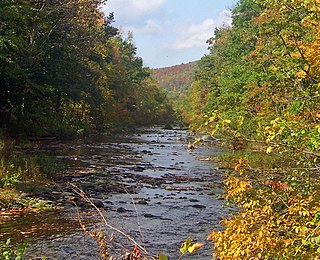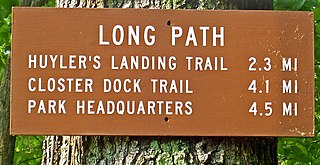
Vernon Township is a township in Sussex County, in the U.S. state of New Jersey. It is located about a one hour drive from New York City and is part of the New York Metropolitan Area. As of the 2020 United States census, the township's population was 22,358, a decrease of 1,585 (−6.6%) from the 2010 census count of 23,943, which in turn reflected a decline of 743 (−3.0%) from the 24,686 counted in the 2000 census. It is both the most populous municipality and the largest in area in the county.

The Wallkill River, a tributary of the Hudson, drains Lake Mohawk in Sparta, New Jersey, flowing from there generally northeasterly 88.3 miles (142.1 km) to Rondout Creek in New York, just downstream of Sturgeon Pool, near Rosendale, with the combined flows reaching the Hudson at Kingston.

Rondout Creek is a 63.3-mile-long (101.9 km) tributary of the Hudson River in Ulster and Sullivan counties, New York, United States. It rises on Rocky Mountain in the eastern Catskills, flows south into Rondout Reservoir, part of New York City's water supply network, then into the valley between the Catskills and the Shawangunk Ridge, where it goes over High Falls and finally out to the Hudson at Kingston, receiving along the way the Wallkill River.

The Long Path is a 357-mile (575 km) long-distance hiking trail beginning in New York City, at the West 175th Street subway station near the George Washington Bridge and ending at Altamont, New York, in the Albany area. While not yet a continuous trail, relying on road walks in some areas, it nevertheless takes in many of the popular hiking attractions west of the Hudson River, such as the New Jersey Palisades, Harriman State Park, the Shawangunk Ridge and the Catskill Mountains. It offers hikers a diversity of environments to pass through, from suburbia and sea-level salt marshes along the Hudson to wilderness and boreal forest on Catskill summits 4,000 feet (1,220 m) in elevation.

Kittatinny Mountain is a long ridge traversing primarily across Sussex County in northwestern New Jersey, running in a northeast-southwest axis, a continuation across the Delaware Water Gap of Pennsylvania's Blue Mountain. It is the first major ridge in the far northeastern extension of the Ridge and Valley province of the Appalachian Mountains, and reaches its highest elevation, 1,803 feet, at High Point in Montague Township. Kittatinny Mountain forms the eastern side of Wallpack Valley; the western side comprises the Wallpack Ridge (highest elevation: 928 feet above sea level.

Wawayanda Creek is the name of Pochuck Creek above its confluence with the tributary Black Creek. It is 17.0 miles (27.4 km) long. Wawayanda Creek, via Pochuck Creek, is a tributary of the Wallkill River in Sussex County, New Jersey in the United States. It starts northeast of Warwick, New York, and runs southwest, mostly within Orange County, flowing into New Jersey for several miles to its confluence with Black Creek just north of Highland Lakes, forming Pochuck Creek, which flows north back into New York.
Pochuck Creek is an 8.1-mile-long (13.0 km) tributary of the Wallkill River in Orange County, New York and Sussex County, New Jersey, in the United States.
New Jersey is a very geologically and geographically diverse region in the United States' Middle Atlantic region, offering variety from the Appalachian Mountains and the Highlands in the state's northwest, to the Atlantic Coastal Plain region that encompasses both the Pine Barrens and the Jersey Shore. The state's geological features have impacted the course of settlement, development, commerce and industry over the past four centuries.

The Black Dirt Region is located in southern Orange County, New York and northern Sussex County, New Jersey. It is primarily located in the western section of the Town of Warwick, centered on the hamlet of Pine Island. Some sections spill over into adjacent portions of the towns of Chester, Goshen and Wawayanda in New York and parts of Wantage and Vernon, New Jersey. Before the region was drained, around 1880 by the Polish and Volga German immigrants through drainage culverts and the construction of the Delaware and Hudson Canal, it was a densely-vegetated marsh known as the "Drowned Lands of the Wallkill".

Wawayanda Mountain is a ridge in the New York-New Jersey Highlands region of the Appalachian Mountains. The summit lies within Sussex County, New Jersey.

The Reading Prong is a physiographic subprovince of the New England Uplands section of the New England province of the Appalachian Highlands. The prong consists of mountains made up of crystalline metamorphic rock.

The Kittatinny Valley is a section of the Great Appalachian Valley in Sussex and Warren counties in northwestern New Jersey that is bounded on the northwest by Kittatinny Mountain, and in the southeast by the New Jersey Highlands region. The valley is roughly 40 miles (64 km) long, with a breadth of 10 to 13 miles.

The Marlboro Mountains, sometimes Marlborough Mountains, are a group of hogbacked mountains arranged in a 25-mile-long (40 km) ridge extending from Newburgh, New York, to just south of Kingston, New York. Considered to be part of the Ridge and Valley Appalachians, the mountains, which reach elevations over 1,100 feet, form an imposing geologic barrier just west of the Hudson River. They subdivide the relatively flat Hudson River Valley to create the Wallkill Valley further west. Rising abruptly on their eastern flanks, the Marlboro Mountains are known for their sweeping views of the region.

The Wallkill Valley is a broad valley extending through southeastern New York and northwestern New Jersey. It is composed of rolling hills, plains, and swamps surrounding the Wallkill River. The valley is a subdivision of the larger Hudson Valley, bound to the west by the Shawangunk Ridge/Kittatinny Mountains and to the east by the Marlboro Mountains and New York–New Jersey Highlands. The northern Wallkill Valley is sometimes associated with the greater Catskills region, although it is geographically separated from the Catskill Mountains by the Shawangunk Ridge and Rondout Valley. In a broader sense, the Wallkill Valley is part of the Ridge-and-Valley physiographic province of the Appalachian Mountains, while the Catskills further to the north and west are part of the Appalachian Plateau.
The Hamburg Mountains are a range of the New York-New Jersey Highlands region of the Appalachian Mountains. The summit, reaching a height of 1,473 feet (449 m), lies within Sussex County, New Jersey.
The Pimple Hills are a range of the New York-New Jersey Highlands region of the Appalachian Mountains. The summit, reaching a height of 1,122 feet (342 m), lies within Sussex County, New Jersey.
The Sparta Mountains are a range of the New York-New Jersey Highlands region of the Appalachian Mountains. The summit, reaching a height of 1,230 feet, lies within Sussex County, New Jersey.
Upper Greenwood Lake is a census-designated place (CDP) in Passaic and Sussex counties, in the U.S. state of New Jersey. It includes residential neighborhoods around the northern and central parts of its namesake lake. It is primarily in West Milford Township in Passaic County but extends to the northwest into Vernon Township in Sussex County. It is bordered to the west by Wawayanda State Park, to the southeast by Abram S. Hewitt State Forest, and to the northeast by the town of Warwick in Orange County, New York.













